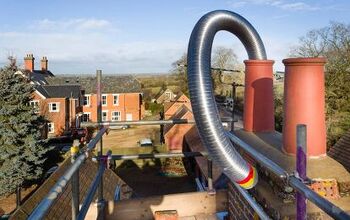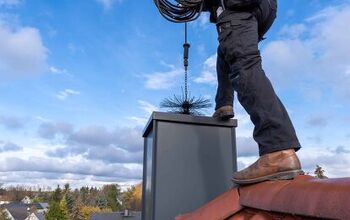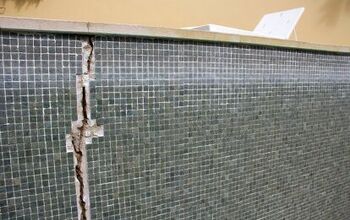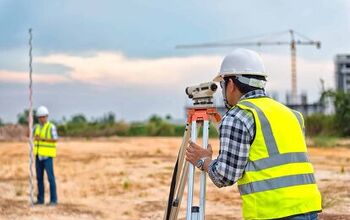2022 Chimney Flashing Cost | Average Repair Rates

Chimney flashing is crucial to protecting your roof, chimney, and the interior of your home from the outdoor elements. Although flashing can last for several years, even in harsh conditions, holes, gaps, and general wear and tear will occur over time. This is why it’s highly recommended to perform yearly inspections, keep up to date with necessary maintenance, and repair issues as soon as they arise.
When left unchecked, damage to your chimney flashing can lead to moisture, debris, and even pests entering your home, harming your interior, attic, and your roofing materials. Whereas, buildup of combustible materials will result in clogs in your chimney, compromising the venting process, interrupting airflow, and potentially allowing carbon monoxide into your home. Your chimney flashing is one of the most vulnerable components of your roof. A brief inspection may reveal minor issues with one area of the flashing or you may find that the entire piece needs to be replaced.
Generally speaking, the cost to repair chimney flashing is between $200 and $500 on average. However, it could cost as much as $2,000 to fix and reseal if you have a large, stone and masonry chimney. In some instances, the damage is too extensive to repair and a full replacement is necessary. The cost of a full chimney flashing replacement ranges from $300 to $1,500, depending on the type of chimney, type of flashing, roofing configuration and materials, and more.
With that said, let’s explore what exactly chimney flashing is, the signs to look out for when it might be time to replace or repair your chimney flashing, and the costs involved. That way, there are no surprises when it comes time to budget for this home improvement project.
Do You Need Chimney Repair Services?
Get free, zero-commitment quotes from pro contractors near you.

What is Chimney Flashing?
Chimney flashing is a crucial component of your chimney and roofing construction for wood-burning and gas fireplaces, as well as wood stoves. Its purpose is to provide a layer of protection around the chimney against water infiltration. Essentially, chimney flashing is weather stripping for your chimney, protecting against water damage. It consists of several layers of material, fastened with caulking and specialized nails to create a weatherproof seal.
There are three major components of chimney flashing: step flashing, counter flashing (also known as cap flashing) and base flashing.
- Step flashing is an L-shaped metal piece that is designed to be installed along a masonry chimney and beneath the roof shingles.
- Counter or cap flashing is also an L-shaped metal sheet, but it’s placed over top of the step flashing and embedded into a pre-cut groove in the chimney’s brickwork.
- Base flashing is installed at the joint between a vertical surface and the surface of the roof. In this case, it’s placed at the base of the chimney, protecting against water penetration.
These three parts, paired with caulk, are what create a watertight seal. Materials used for chimney flashing vary considerably based on the chimney type, local climate, and the roofing material and design. Though, the most common materials are terne-coated stainless steel, galvanized sheet metal, vinyl, aluminum, and copper.
It is important that your flashing material is compatible with your roofing system, and the nails used are of the same material as well. This helps avoid corrosion caused by mixing metals.
Signs You Need to Repair Chimney Flashing
If your chimney flashing starts to fail and leak, this can lead to significant damage to your roofing, attic, and interior spaces. Your chimney itself could even sustain damage – which is why it’s so important to be aware of the signs that your chimney flashing may need repairs or replacement.
Chimney flashing that is correctly installed and maintained can last up to 30 years. Though, the actual lifespan is dependent on where you live, the local climate, flashing material, and chimney size and shape. If you’re not sure when your flashing may need to be replaced, knowing the age of your home is an excellent starting point as this should indicate when the chimney was built.
In addition to knowing your home’s age, you should perform a throughout inspection of your chimney, roof, and flashing to find any leaks or issues before they become major problems. A visual inspection should allow you to detect any of the following warning signs that it may be time to repair or replace your chimney flashing:
- Water leaks occurring in the inside or the outside of the chimney
- Sounds and evidence of dripping, such as puddles
- Rust stains inside or outside the chimney
- Discoloration, creosote buildup, and sedimentation on bricks
- Water stains on interior walls and ceilings adjacent to the chimney
- Visible holes or gaps in the caulking or flashing itself around the chimney
Water leaks are one of the main signs of chimney flashing failure, and spring is the most common time for a chimney leak to occur. Since spring is the wettest time of year, this is likely when homeowners are going to notice flashing issues. As snow melts and rain storms occur, more moisture gets introduced that can leak into your home via gaps and cracks in your flashing.
Chimney Flashing Repair Cost
Every roof and chimney will have unique needs, and the cost to repair flashing varies based on the type of flashing, type of chimney, chimney size, roofing configuration, roofing materials, and the extent of the damage. In some cases, the only thing needed to fix a leak is to reseal the flashing with roofing cement, polyurethane caulk, or some other type of flashing sealant. However, this assumes that the flashing was initially installed correctly and is not warped or flaring on the edges.
With that said, chimney flashing repair ranges from $200 to $500 on average. This includes fixing and resealing the flashing. The larger the chimney, the more expensive it will be to seal. You will also typically pay more for repairs if your roof or chimney has an unusual configuration, geometry, or any abnormal angles. Larger stone or brick chimneys often require “flank” flashing to be installed down the sides of the chimney and to the ground below. In this instance, you could pay up to $2,000 to have the flashing repaired.
As soon as you notice that your flashing needs some sort of remediation, you should reach out to a professional to correct the problem. Leaving damaged chimney flashing unchecked can result in further damage to your roof, and possibly to the rest of your home.
Note: A chimney sweep or mason are the professionals that handle chimney flashing repairs.
Cost to Replace Chimney Flashing
In some cases, whether the flashing is significantly damaged or corroded, you may have to replace it altogether. Costs for a full chimney flashing replacement range from $300 to $1,500, depending on the type of chimney. Like repair costs, you can expect to pay more on flashing replacement for larger chimneys or those that have unusual configurations or shapes.
The cost of chimney flashing replacement also varies based on the material you choose for the flashing. Copper is typically the most expensive choice, followed by galvanized and stainless steel, with aluminum being the most affordable. Each material comes with its own individual benefits, depending on your local climate.
Chimney Flashing Replacement by Chimney Type
| Chimney Type | Average Replacement Cost Range |
| Metal Chimney | $300 to $500 |
| Stone and Masonry Chimney | $500 to $1,500 |
Additional Costs of Chimney Flashing Repair
In addition to chimney flashing cost, you’ll also want to budget appropriately for chimney inspection costs, cleaning costs, and other necessary chimney services. In some instances, damaged chimney flashing can result in undesirable buildup and debris in various areas of the chimney, such as the smoke chamber, walls, and flue liner.
Your chimney inspector will be able to properly investigate the area around your chimney and advise you on the repairs and cleaning services that may be needed. Although in some cases, chimney flashing repair may be as easy as resealing the area around your chimney, the damage caused by leaking flashing can raise repair costs significantly. Moisture is one of the greatest enemies to your chimney, and can result in substantial damage to the brick, mortar, damper, flue, and other components of your chimney.
Over time, moisture can corrode and break down the various parts of your chimney and roof, encouraging mold and mildew growth in your roofing materials, attic, insulation, and even the interior of your home. Because of this, it is so important to complete a full replacement when you find that your chimney flashing has deteriorated or is considerably damaged.
DIY vs. Hiring a Professional
Although repairing or replacing your chimney flashing yourself may seem like the more cost-effective option for you, this project requires some serious skill, experience, and dexterity. As the flashing is located on the roof, repairs and flashing replacements will occur at a height of 30 feet, or higher.
For a DIY repair, you must be able to accurately measure the angles of your roof and chimney. You also need to know how to properly nail, seal, and caulk the flashing, to ensure that you don’t have leaking flashing. While DIY chimney flashing repair or replacements are possible, it is both safer and more cost-effective in the long run to leave the task to professionals.
However, if you’re still considering taking on the job yourself, consider the following:
Safety Precautions
To access your roof and the chimney flashing, you need to use an extension ladder and have someone at the bottom to steady and secure it. Once you get up to your roof, you must take each step carefully, especially when walking at an angle. It’s more common than you think for homeowners to fall off of their roof – particularly those who don’t know what they’re doing.
When the old flashing is removed, you have to be extra careful to avoid getting cut or injured by the sharp, sheets of metal. To correctly repair the chimney flashing, you also must have all the necessary tools and supplies. This includes heavy-duty gloves, protective eyewear, and grippy work boots. In most cases, you may also need to install a roof jack.
Tools and Material Considerations
In addition to having the correct tools, you also need to have the proper materials. To ensure that the flashing is cut correctly, accurate chimney measurements need to be taken. All of the measurements, cutting, and bending of the flashing material must be done prior to climbing up on the roof and performing the installation.
Time Considerations
There’s only a limited amount of time that one individual can work on the repairs or replacement of their own chimney flashing. Ideally, the work should begin in the early morning before the sun has started to heat up your roof throughout the day. In hot weather, shingles and adhesive heat up and become more moldable and flexible – which makes them more difficult to remove.
In general, the excessive heat may be difficult to work in if you’re not used to it. Once the shingles have been removed, it’s important to note that the longer your roof doesn’t have shingles or flashing while you work, the more vulnerable it is to damage. Take a look at this guide when the time comes for you to remove your chimney.
Tips to Save Money on Chimney Flashing
The best thing you can do to avoid spending too much money on chimney flashing repairs is to perform regular inspections and maintenance on your chimney, roof, and all related components. Conducting frequent visual inspections will ensure that your flashing stays in good condition, while also allowing you to detect potential issues before they get worse and lead to costlier repairs.
Routine Inspections
Make sure that you have a certified chimney sweep perform a level 2 inspection on your chimney every year. You can consult the Chimney Safety Institute of America (CSIA) to verify if a chimney sweep is properly certified. In addition to having a professional perform an inspection, you should also conduct your own visual inspections regularly.
Keep a lookout for signs of rust, corrosion, and creosote buildup on your chimney and chimney flashing. As soon as your flashing starts to show signs of deterioration, repair or replace it. Staying on top of these issues prevents corroded spots from becoming holes that let water leak into your home.
Caulking and Sealing
Inspect the caulking on your chimney flashing and have it touched up or reapplied on a regular basis. This will help ensure that you maintain a waterproof barrier between the interior of your home and the outdoors. Oftentimes, caulking is the first thing to go when it comes to chimney flashing. However, it is the easiest component to repair if the damage is detected early enough.
Regular Maintenance
Since your chimney flashing is a part of both your roofing and your chimney system, chimney sweeping, fireplace cleaning, chimney inspections, and roof maintenance are crucial to ensuring that your chimney and your home are kept safe. Moisture, broken bricks and tiles, corrosive substances, and other problems can cause damage to the chimney flashing and compromise its efficacy.
With that said, keeping up with all the necessary roofing maintenance, chimney cleaning, and simple repairs can keep your flashing repair and replacement costs low.
Never Delay Repairs
To save money on chimney flashing repairs, make sure that you address problems as soon as they arise. Holding off on repairs will only allow water, pests, and other contaminants to further infiltrate your home and cause additional damage that is more expensive to fix. Although it may be tempting to wait until you have more cash on hand, it’s more cost-effective in the long run to take care of problems immediately.
Get Financing
If you feel that the cost of chimney flashing is too much for your current budget, there’s no need to stress! There are plenty of helpful financing options out there for homeowners that can help you get the necessary repairs quickly and save you money long term. Many chimney and roofing repair companies will offer financing with them, but make sure that you look into other financing options to ensure that you get the best interest rate.
How to Repair Chimney Flashing
In some cases, leaking chimney flashing may be repaired by resealing it with new caulk or roofing cement. Though, if the flashing is warped, flared, damaged, or worn beyond repair, a full replacement may be necessary. The following procedure is used by chimney professionals to properly remove and replace chimney flashing:
- First, the current chimney flashing and shingles around the chimney are removed.
- Then, base flashing is attached around the base of the chimney.
- Sections of step flashing and shingles are overlapped and intertwined to direct water away from the chimney and the roof.
- Next, the front flashing, back flashing, and side flashing are installed on the chimney.
- Finally, the counter flashing is put in place and caulk is used to ensure a strong, watertight seal.
Do You Need Chimney Repair Services?
Get free, zero-commitment quotes from pro contractors near you.

Related Questions
How long should chimney flashing last?
When properly installed, chimney flashing should last over 30 years. However, its actual longevity depends on the materials used, the shape, size, and type of your chimney, and your local climate.
How do I know if my chimney flashing is leaking?
The best way to determine that a leaking roof is caused by your chimney flashing and not something else is to run a low-pressure hose around your chimney and roof intersection. You’ll likely need two people for this test, one to operate the hose and the other to inspect the attic. If you notice water inside the attic upon running the hose, you need to have your chimney flashing repaired.
Is chimney flashing necessary?
In short, yes, chimney flashing is absolutely necessary. If you have recently moved into a home or haven’t performed work on your chimney in quite a while, you should look out for signs of faulty chimney flashing. Your chimney flashing is one of the most common contributors to chimney leaks and you can have major problems if it’s not addressed immediately.
Can Flex Seal be used on chimneys?
Yes, Flexible Seal can adhere to metal flashing, brick, and the majority of roofing materials while also providing a waterproof seal.
How does chimney flashing deteriorate?
Chimney flashing can start to wear over time for a number of reasons including, but not limited to weather damage, corrosion, improper installation, dents, separation, and age.
Related Articles

Jessica considers herself a home improvement and design enthusiast. She grew up surrounded by constant home improvement projects and owes most of what she knows to helping her dad renovate her childhood home. Being a Los Angeles resident, Jessica spends a lot of her time looking for her next DIY project and sharing her love for home design.
More by Jessica Stone



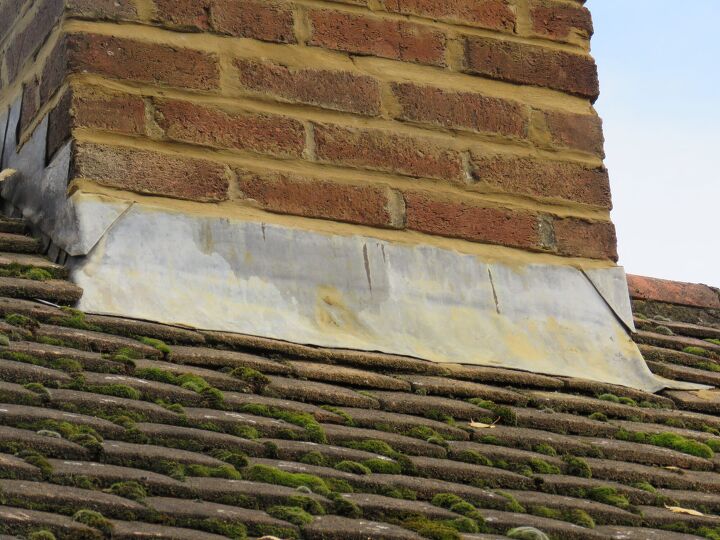
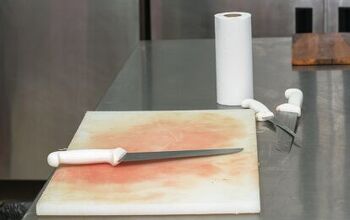





![How Much Does Dryer Repair Cost? [Average Rates by Part]](https://cdn-fastly.upgradedhome.com/media/2023/07/31/9103276/how-much-does-dryer-repair-cost-average-rates-by-part.jpg?size=350x220)
